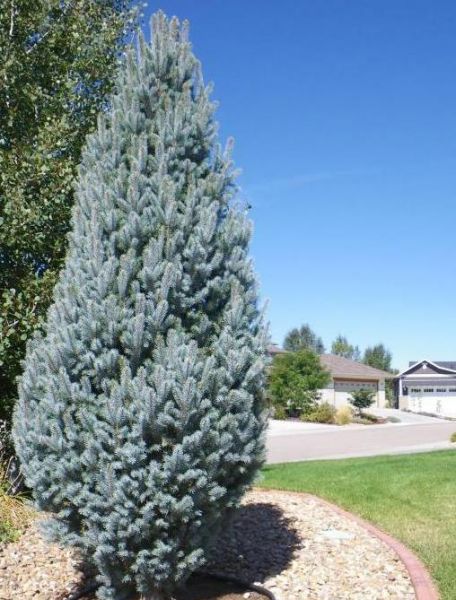 An evergreen that has had a starring role in the mountains of Arizona is gaining nationwide popularity. The ‘Single Blue Pinyon Pine’ is a new local variety that gives a bold appearance to a rustic tree. Its blue color blends well in dry mountain landscapes as well as modern and Mediterranean style gardens. The tidy appearance and unusual blue color is stunning, but this tree is gaining popularity at farmers’ markets for its pine nut production. Even at a young age the tree produces pinecones with melt-in-your-mouth nuts. Let it grow wild to 10’ or, for a perfect Christmas tree shape, prune it right after its spring growth.
An evergreen that has had a starring role in the mountains of Arizona is gaining nationwide popularity. The ‘Single Blue Pinyon Pine’ is a new local variety that gives a bold appearance to a rustic tree. Its blue color blends well in dry mountain landscapes as well as modern and Mediterranean style gardens. The tidy appearance and unusual blue color is stunning, but this tree is gaining popularity at farmers’ markets for its pine nut production. Even at a young age the tree produces pinecones with melt-in-your-mouth nuts. Let it grow wild to 10’ or, for a perfect Christmas tree shape, prune it right after its spring growth.
January is an excellent month for planting evergreens. The timing is perfect for those using living trees as decorations during the holidays and then planting them after the New Year.
Because of their waxy needles and high internal pitch most conifers need surprisingly little water. Once these trees get up to size our arid climate, dry soil, and extreme temperatures seem to keep these conifers happy. This holds true for most the high country natives like pine, cypress, cedar, and juniper.
These trees, especially the native pines, have trouble with our crummy mountain soil. They do not like to sit in wet soggy soils. The trees’ internal metabolism is slowed to an almost stasis like state. New root hairs will form along with next spring’s candle buds as long as the soil drains properly. That’s why digging the right size planting hole and adding the correct soil amendments are critical towards a successful planting.
Here are six steps to plant an evergreen tree successfully, no matter the season.
Step 1 – The bowl-shaped hole should be the same depth as the root ball, but three times as wide. Plants do not need a deep hole; they thrive when able to stretch out just under the surface of the soil in search of food and water. This is why a bowl-shaped hole promotes the best root development. Rid the hole of rocks and debris larger than a golf ball.
Step 2 – Improve the planting soil by amending with composted mulch. Good mulch will keep clay soils loose and aerated, and in loose granite will retain water up around the root ball.
The amount of mulch per plant should be equal to the size of the root ball. That is the quantity of mulch you will need to blend into the native soil used to fill in around each plant.
Step 3 – Evergreen trees are so sensitive to soggy soil that it is recommended they be planted on a slight mound. Whatever you do, don’t bury the plant; keep the trunk out of the soil. The top of the root ball you see in the grower’s pot should still be able to see sunlight once planted.
Step 4 – Evergreens need the right plant food for a healthy start. Use my specially blended “All-Purpose Plant Food” 7-4-4, specifically designed for mountain plants. Just sprinkle the granules on top of the root ball and water in well. The slow-release nutrients promote a deep green color, while encouraging thicker root formation each time you water.
Step 5 – Promote deeper roots with ‘Root & Grow’. Add this liquid rooting hormone to the water you use to saturate the root ball. It forces many new root hairs to grow into the surrounding soil. More roots mean a more vigorous plant. Use this root tonic once per month until new candle growth emerges in spring.
Step 6 – Top dress the planting area with a 3 inch layer of shredded cedar bark. This extra layer of nature’s insulation holds moisture in, keeps weeds out, and protects from extreme temperature swings. It is like pulling a thick wool blanket over the roots when they are cold and shivering.
Water – Keep the tree moist, but allow it to dry between waterings. Give it a thorough soak twice per month throughout the winter. Once new growth is experienced, bump the water schedule up to twice a week during the first growing season, them once a week thereafter.
For exact planting details that include drawings and measurements, ask for my “Guide to Mile High Planting” the next time you visit the garden center. You might also like the useful companion guide “Mile High Watering”.
Until next week, I’ll see you in the garden center.
Ken Lain, “my personal mission is to help local homeowners garden smarter and get our local garden timing right.” Throughout the week Ken can be found at Watters Garden Center located at 1815 W. Iron Springs Rd, Prescott, or may be contacted through his web site at www.wattersgardencenter.com

